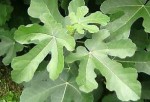 Native to the Middle East and Asia this deciduous shrub or small tree is a member of the mulberry family, Moraceae, that also includes banyan, breadfruit, and Osage-orange. It grows 20-40′ tall and has attractive smooth silver-gray bark and wide spreading branches that may become very picturesque with maturity. The hairy, palmate leaves are dark green on the upper side and light green below. The leaves have three to five lobes, are up to twelve inches long, and have toothed or wavy margins. The greenish flowers are produced in spring inside a modified stem tip and are not visible. The “fruit” actually consist of many fruits within the modified stem tip and ripens in late summer to fall. Plants set fruit best in hot dry areas and may produce two crops. The plant has been cultivated since ancient times for the fruits but it also has ornamental appeal. The genus name, Ficus, is the classical Latin name for the common fig. The specific epithet, carica, comes from the Greek word karike, the name of a kind of fig.
Native to the Middle East and Asia this deciduous shrub or small tree is a member of the mulberry family, Moraceae, that also includes banyan, breadfruit, and Osage-orange. It grows 20-40′ tall and has attractive smooth silver-gray bark and wide spreading branches that may become very picturesque with maturity. The hairy, palmate leaves are dark green on the upper side and light green below. The leaves have three to five lobes, are up to twelve inches long, and have toothed or wavy margins. The greenish flowers are produced in spring inside a modified stem tip and are not visible. The “fruit” actually consist of many fruits within the modified stem tip and ripens in late summer to fall. Plants set fruit best in hot dry areas and may produce two crops. The plant has been cultivated since ancient times for the fruits but it also has ornamental appeal. The genus name, Ficus, is the classical Latin name for the common fig. The specific epithet, carica, comes from the Greek word karike, the name of a kind of fig.
 Type: Deciduous tree
Type: Deciduous tree
Outstanding Feature: Foliage, fruit, bark, habit
Form: Broad, rounded crown
Growth Rate: Slow
Bloom: Greenish flowers are produced in spring within a modified step tip and are not visible
Size: 20-40’ H x 30-60’ W
Light: Sun; tolerates some shade
Soil: Prefers average, moist, well-drained soil but tolerates a wide variety of soils
Hardiness: Zones 8-10 (6 and 7 with protection)
Care: Prune young trees to allow three to four main branches
Pests and Diseases: Scale, red spider,
Propagation: Seed, grafting, air-layering, ground layering, hardwood cuttings, softwood cuttings with mist
Outstanding Selection:
‘Brunswick’ (for fruiting ability)
‘Brown Turkey (for hardiness)
‘Chicago Hardy’ (for hardiness)